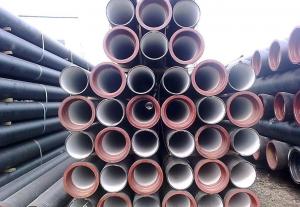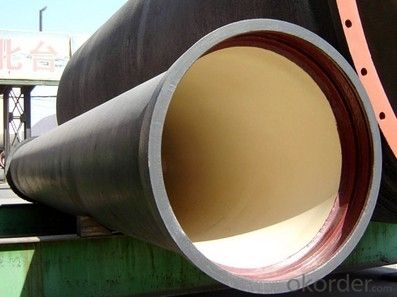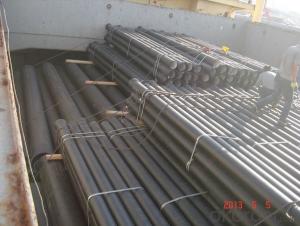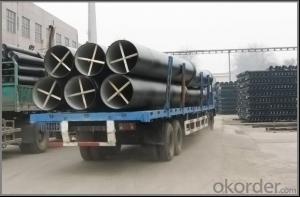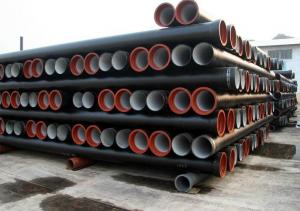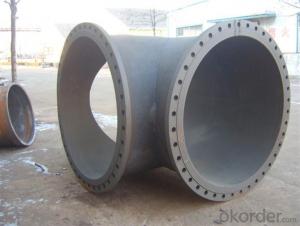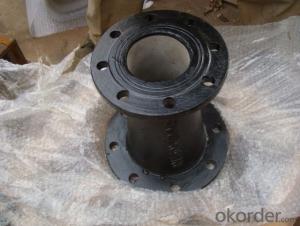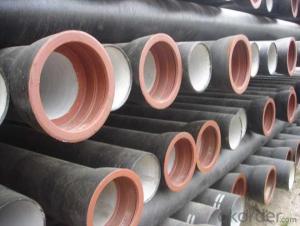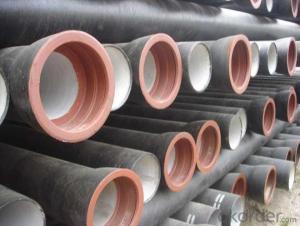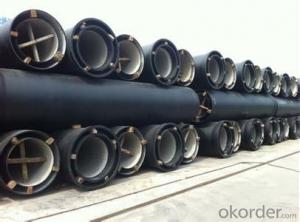Ductile Iron Pipe EN545/EN598 DN800 High Quality
- Loading Port:
- China main port
- Payment Terms:
- TT or LC
- Min Order Qty:
- 1000 m
- Supply Capability:
- 500000 m/month
OKorder Service Pledge
OKorder Financial Service
You Might Also Like
1. Ductile Iron Pipe Description :
It has high strength & hardnes as steel and better corrosin resistance than steerl and grey iron, I ductile iron pipe is the ideal substute for gray cast iron pipe and common steel pipe. In addition, our DI pipes are produced with good straightness, identical wall thickness, high dimension accuracy, smooth surface finished, remarkable mechanical properties and firmly sticking internal & external coating layer as well. Flexible Push-in joint and rubber gasket are used for more convenient installation of pipelines.
2. Ductile Iron Pipe Main Features:
1. ISO 2531 or EN 545 Standard K9 Class, K7 Class and C Class
2. ISO 9001 Certificate
3. ISO 2531 & EN 545 Certificate
4. WRAS Potable Water Certificate for Cemen Internal Lining
5. WRAS EPDM Rubber Gasket or NBR Rubber Gasket
6. DN80mm - DN2600mm
7. Black Bitumen or Blue Epoxy Coating
8. Lengh = 6m or cut into 5.6m, 5.7m, 5.8m
3.Ductile Iron Pipe Images:
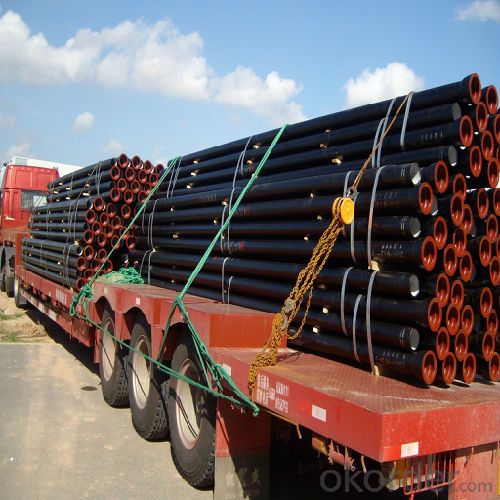
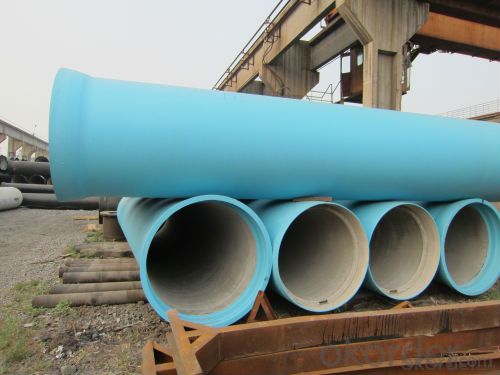
4.Ductile Iron Pipe Specification:
1) The standard of pipe: ISO2531:1998, K9
2) Effective length: 6m
3) Inner cement line: Portland cement line as per ISO4179
4) Zinc coating: at least 130g/m2 as per ISO8179
5) Bitumen painting: at least 70um as per ISO8179
6) With 100% quantity of NBR ring, or SBR ring, or EPDM ring as per ISO4633
7) DN80mm-800mm
8) High strength, lighter than grey iron, good corrosion resistance, no furring, small flow resistance, easy fixing, long life tome about 100 yeas
9) Checked by automatic inspection equipment
5.FAQ:
· Management Systems-Internal Software
· Finished Product Inventory-More Than 5000 Tons.
· Raw Material inventory -Over 8000 Mertic Tons.
· The most convenient transport and prompt delivery.
· Competitive price with best service .
· High technical production line with top quality products.
· High reputation based on best quality products.
- Q: What is the lifespan of ductile iron pipes?
- The durability and longevity of ductile iron pipes can vary depending on several factors, including pipe quality, installation conditions, and the surrounding environment. On average, these pipes typically last between 50 and 100 years, making them an excellent choice for water and sewer infrastructure. By implementing proper maintenance practices and conducting regular inspections, ductile iron pipes can remain highly functional and efficient for many decades. It should be noted that factors such as corrosion, soil conditions, and water chemistry can influence the lifespan of these pipes, so it is important to monitor and address these issues in order to extend their longevity.
- Q: What is the expected thermal expansion coefficient of ductile iron pipes?
- The expected thermal expansion coefficient of ductile iron pipes varies depending on several factors, including the specific composition of the iron and the temperature range in which the pipes are being used. However, as a general guideline, the thermal expansion coefficient of ductile iron pipes typically falls within the range of 10 to 14 x 10^-6 per degree Celsius (10-14 μm/m°C). This means that for every degree Celsius increase in temperature, a ductile iron pipe will expand by approximately 10 to 14 micrometers per meter of length. It is important to note that these values are approximate and may vary depending on the specific conditions and application of the pipes.
- Q: Can ductile iron pipes be used in high-temperature applications?
- Yes, ductile iron pipes can be used in high-temperature applications. Ductile iron has excellent heat resistance properties, with a maximum recommended operating temperature of around 450 degrees Fahrenheit. This makes it suitable for a wide range of industrial and commercial applications where high temperatures are involved, including steam, hot water, and thermal oil systems.
- Q: Can ductile iron pipes be used for both water and sewage systems?
- Yes, ductile iron pipes can be used for both water and sewage systems. Ductile iron pipes are known for their high strength and durability, making them suitable for a wide range of applications, including water supply and sewage systems. These pipes have a high resistance to corrosion, making them ideal for carrying both clean water and sewage. Additionally, ductile iron pipes have excellent mechanical properties, allowing them to withstand the high pressure and stress that can be present in water and sewage systems. Therefore, ductile iron pipes are a reliable and versatile choice for both water and sewage systems.
- Q: What are the typical joint restraint requirements for ductile iron pipes under pressure?
- In order to meet the joint restraint requirements for ductile iron pipes under pressure, there are two common options available: mechanical joint restraints and restrained joint systems. These restraints are essential to prevent separation or pulling apart of the pipes caused by internal pressure. A mechanical joint restraint, which is widely used, involves a series of bolts and clamps that securely hold the pipes together. These restraints are applied at each joint of the ductile iron pipes to ensure a tight and secure connection. By providing axial restraint, they prevent the pipes from separating along the pipe axis. Another option is the restrained joint system, which offers both axial and angular restraint. This system includes a specially designed joint that consists of a gasket, a restraining gland, and a series of bolts or wedges. The gasket ensures a watertight seal, while the restraining gland and bolts/wedges restrain the pipe joints, preventing separation under pressure. The specific requirements for joint restraints may vary depending on factors such as the pipe's diameter, wall thickness, and operating conditions. To determine the appropriate joint restraint system for a specific application, it is crucial to consult the manufacturer's guidelines and industry standards. Furthermore, proper installation and maintenance of the joint restraints are essential to ensure their effectiveness and longevity in restraining the pipes.
- Q: What are the recommended bedding and backfill materials for ductile iron pipe?
- To ensure proper alignment and prevent damage during installation and operation, ductile iron pipe requires a combination of granular materials such as sand, gravel, or crushed stone for bedding and backfill. Bedding involves using sand to create a level surface, distributing the load evenly and reducing stress concentration. As for backfill, it should be carefully selected to offer good compaction and drainage properties, preventing settling and potential damage. Common choices for backfill are crushed stone or gravel, which provide stability and allow for proper compaction. To ensure the long-term performance and durability of the pipe system, it is crucial to adhere to the recommendations of the pipe manufacturer and relevant industry standards when selecting bedding and backfill materials. These materials must meet specified size and quality requirements. Additionally, local regulations and soil conditions should also be considered when determining the appropriate bedding and backfill materials for ductile iron pipe installations.
- Q: Can the underground cast iron pipes be connected with clamps to form buttress?
- Best not to, because the use of clamp connection way to connect the poor integrity of the pipeline, the base treatment is not in place or uneven settlement, it is easy to produce deformation, resulting in pipe bending deformation, easily leaked from the junction.
- Q: What are the advantages of using ductile iron pipe?
- Using ductile iron pipe in various applications offers several benefits. Firstly, ductile iron pipe is renowned for its strength and durability. It possesses higher tensile and yield strengths compared to other pipe materials, making it highly resistant to cracking, bending, and breaking. This exceptional strength enables the pipe to withstand high-pressure and heavy-load conditions, making it an ideal choice for applications such as water and sewage systems, oil and gas pipelines, and industrial piping. Secondly, ductile iron pipe exhibits excellent corrosion resistance. It is coated with a protective layer, typically zinc or epoxy, which prevents rusting and corrosion. This coating ensures a longer lifespan for the pipe, even in harsh environments or when transporting corrosive fluids. Another advantage of ductile iron pipe lies in its flexibility. Unlike rigid pipes, ductile iron pipes possess a certain level of flexibility, enabling them to endure ground movements and settle without fracturing. This flexibility proves particularly advantageous in areas prone to earthquakes or soil settlements. Additionally, ductile iron pipe boasts a smooth inner surface, minimizing flow resistance and enhancing fluid transportation efficiency. It also reduces the likelihood of sediment accumulation or corrosion within the pipe, resulting in improved flow rates and decreased maintenance requirements. Furthermore, ductile iron pipe proves cost-effective in the long run. Although it may entail higher initial costs compared to other pipe materials, its durability and minimal maintenance needs make it a cost-effective choice over time. The extended lifespan of ductile iron pipe reduces the necessity for frequent replacements and repairs, contributing to lower overall life-cycle expenses. Lastly, ductile iron pipe exhibits environmental friendliness. It is manufactured using recycled materials, and its extended lifespan diminishes the need for frequent replacements, thereby reducing the carbon footprint associated with manufacturing and transportation. In conclusion, the utilization of ductile iron pipe offers numerous advantages, including exceptional strength, corrosion resistance, flexibility, smooth inner surface, cost-effectiveness, and environmental friendliness. These qualities establish it as a reliable and preferred option for various applications across diverse industries.
- Q: Are ductile iron pipes suitable for wastewater pumping stations?
- Ductile iron pipes are well-suited for pumping stations that handle wastewater. This material is known for its strength and durability, making it capable of withstanding the tough and corrosive properties of wastewater. It boasts exceptional resistance against wear, corrosion, and impact, which makes it a dependable choice for wastewater applications. Moreover, ductile iron pipes possess a high tensile strength and can handle high-pressure situations, thus proving their suitability for pumping stations that transport wastewater across long distances or elevated areas. The smooth inner surface of ductile iron pipes also aids in reducing friction, promoting the smooth flow of wastewater and minimizing the risk of blockages. In conclusion, ductile iron pipes offer a cost-effective and durable solution for wastewater pumping stations.
- Q: How to properly maintain FRP pipes
- Length of single pipe lengthReduce pipe connection, speed up installation, improve the quality of the whole pipeline.
Send your message to us
Ductile Iron Pipe EN545/EN598 DN800 High Quality
- Loading Port:
- China main port
- Payment Terms:
- TT or LC
- Min Order Qty:
- 1000 m
- Supply Capability:
- 500000 m/month
OKorder Service Pledge
OKorder Financial Service
Similar products
Hot products
Hot Searches
Related keywords
